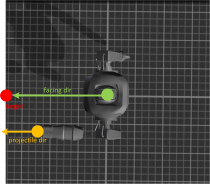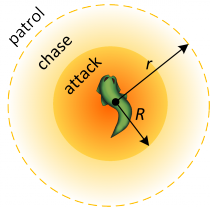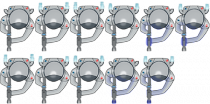Author Archives: Rokas Paulauskas

Big Game Project: Week 7
This is the last post and it covers my work during the last week (May 16 – May 20) of the Big Game Project.
You probably remember the ranged attack of Enemy type 2, a slow-moving laser from the previous post. This attack was, however, not included in the final version and instead had to be replaced with a usual projectile type weapon that fires periodically with a short delay. I don’t think the original laser weapon was wrong but since the shooting […]

Big Game Project: Week 7
This is the last post and it covers my work during the last week (May 16 – May 20) of the Big Game Project.
You probably remember the ranged attack of Enemy type 2, a slow-moving laser from the previous post. This attack was, however, not included in the final version and instead had to be replaced with a usual projectile type weapon that fires periodically with a short delay. I don’t think the original laser weapon was wrong but since the shooting […]
Big Game Project: Week 6
We, Do It Youself Games, have been working on our game, Kei, for six weeks now. We are approaching the point where no more content should be added to the game (“feature complete”) and where the developmental work should be focused on polishing and bug-fixing.
Yet up to this sixth week (May 9 – May 13) there still was one big feature that was an absolute must – that is Kei’s ranged attack (the Chakra). Adding this type of attack is the […]
Big Game Project: Week 6
We, Do It Youself Games, have been working on our game, Kei, for six weeks now. We are approaching the point where no more content should be added to the game (“feature complete”) and where the developmental work should be focused on polishing and bug-fixing.
Yet up to this sixth week (May 9 – May 13) there still was one big feature that was an absolute must – that is Kei’s ranged attack (the Chakra). Adding this type of attack is the […]
Big Game Project: Week 5
The fifth week (May 2 – May 6) development of our game “Kei” is halfway through. This week I worked on the second enemy type, dubbed Beta. According to the Project Plan, this enemy type should have both a ranged and a melee attack.
I implemented a ranged attack for the Beta type robot, a deadly slow-moving laser beam. This could be the highlight of the week’s developmental work (though I also worked on other minor fixes). You can preview this laser attack […]
Big Game Project: Week 5
The fifth week (May 2 – May 6) development of our game “Kei” is halfway through. This week I worked on the second enemy type, dubbed Beta. According to the Project Plan, this enemy type should have both a ranged and a melee attack.
I implemented a ranged attack for the Beta type robot, a deadly slow-moving laser beam. This could be the highlight of the week’s developmental work (though I also worked on other minor fixes). You can preview this laser attack […]
Big Game Project: Week 4
The fourth week (Apr 25 – Apr 29) development of our game “Kei” continues. This week I was working on an experimental feature in the game, the auto-locking system.
All considerations here are about melee attack (the player will also have ranged attack but it hasn’t been implemented yet). When you attack an enemy, the collider placed around your sword has to collide with the enemy’s collider in order for the hit to be registered. Since the sword object is relatively small compared […]
Big Game Project: Week 4
The fourth week (Apr 25 – Apr 29) development of our game “Kei” continues. This week I was working on an experimental feature in the game, the auto-locking system.
All considerations here are about melee attack (the player will also have ranged attack but it hasn’t been implemented yet). When you attack an enemy, the collider placed around your sword has to collide with the enemy’s collider in order for the hit to be registered. Since the sword object is relatively small compared […]
Big Game Project: Week 3
The third week (Apr 18 – Apr 22) I worked mostly with Enemy 1 (“Alpha”) AI. I experimented with two different AI behaviors:
where the enemy follows the player during its attack phase and deals damage to the player upon contact (because of its rapidly spinning hull)
where the enemy charges towards the player in a straight line dealing damage on contact; the player can more easily evade the attack by moving off of the straight line
The latter behavior feels too simplistic and too easy […]
Big Game Project: Week 3
The third week (Apr 18 – Apr 22) I worked mostly with Enemy 1 (“Alpha”) AI. I experimented with two different AI behaviors:
where the enemy follows the player during its attack phase and deals damage to the player upon contact (because of its rapidly spinning hull)
where the enemy charges towards the player in a straight line dealing damage on contact; the player can more easily evade the attack by moving off of the straight line
The latter behavior feels too simplistic and too easy […]
Big Game Project: Week 2
The second week (Apr 11 – Apr 15) development of our game “Kei” continues. This week I kept on working on the main character (Kei). The focus this week, however, was player animations. Our graphics artists produced a 3D model our main character as well as her Idle, Run and Attack animations. I implemented these animations into the game.
To do it, I learned the basics of Unity’s Blend Trees. A blend tree blends two or more animations and produces intermediate animations […]
Big Game Project: Week 2
The second week (Apr 11 – Apr 15) development of our game “Kei” continues. This week I kept on working on the main character (Kei). The focus this week, however, was player animations. Our graphics artists produced a 3D model our main character as well as her Idle, Run and Attack animations. I implemented these animations into the game.
To do it, I learned the basics of Unity’s Blend Trees. A blend tree blends two or more animations and produces intermediate animations […]
Big Game Project: Week 1
Two weeks ago, the Big Game Project (Stora spelprojektet) course started. This course is the last one in my two years’ game design and programming education. It is also one of the landmarks of this study program since the games produced by students in this course will be presented at the GGC (Gotland Game Conference) where also the best games will be selected by voting.
In this eight-week period I’ll be working as a programmer for Nayomi’s group. Our game called “Kei” […]
Big Game Project: Week 1
Two weeks ago, the Big Game Project (Stora spelprojektet) course started. This course is the last one in my two years’ game design and programming education. It is also one of the landmarks of this study program since the games produced by students in this course will be presented at the GGC (Gotland Game Conference) where also the best games will be selected by voting.
In this eight-week period I’ll be working as a programmer for Nayomi’s group. Our game called “Kei” […]
Write Smart Code
When you write source code, the more meaning you can pack in the same number of code lines, the better. The code becomes “less verbose” and more difficult to fathom but to a programmer’s eye, it also becomes more elegant.
Below are some tricks which I learned during the courses Game Programming I and II. Most of them aren’t anything special and are probably obvious to an experienced programmer but I still notice a lot of my colleague students still prefer […]
Write Smart Code
When you write source code, the more meaning you can pack in the same number of code lines, the better. The code becomes “less verbose” and more difficult to fathom but to a programmer’s eye, it also becomes more elegant.
Below are some tricks which I learned during the courses Game Programming I and II. Most of them aren’t anything special and are probably obvious to an experienced programmer but I still notice a lot of my colleague students still prefer […]

The Last Signal. Post #6: AI for enemy type 2
This is the last post which is required in the course 5SD033 – Introduction to Game Development.
Over the period of about 2 months, our game, “The Last Signal”, has evolved from nothing to almost a playable game – with colourful backgrounds, vivid animations for the player and the enemies, power-ups and a room transition system. The game employs data-driven object creation (rooms, animations and sound effects are created during run-time from data in external text files), some interesting AI and player movement control with the mouse.
There […]

The Last Signal. Post #6: AI for enemy type 2
This is the last post which is required in the course 5SD033 – Introduction to Game Development.
Over the period of about 2 months, our game, “The Last Signal”, has evolved from nothing to almost a playable game – with colourful backgrounds, vivid animations for the player and the enemies, power-ups and a room transition system. The game employs data-driven object creation (rooms, animations and sound effects are created during run-time from data in external text files), some interesting AI and player movement control with the mouse.
There […]

The Last Signal. Post #5: full animation system implementation
In this post, I’m going to go into the details of creating a full-blown animation system for our game, something I had promised to do sometime in the future in the previous post.
How animations work in (2D) video games
In video games, the effect of animation is achieved by very quickly switching between pictures which depict the same character/object/effect etc. at slightly different times. If switched sufficiently quickly, the sequence of frames will give the impression of smooth continuous motion.
In our […]

The Last Signal. Post #5: full animation system implementation
In this post, I’m going to go into the details of creating a full-blown animation system for our game, something I had promised to do sometime in the future in the previous post.
How animations work in (2D) video games
In video games, the effect of animation is achieved by very quickly switching between pictures which depict the same character/object/effect etc. at slightly different times. If switched sufficiently quickly, the sequence of frames will give the impression of smooth continuous motion.
In our […]

The Last Signal. Post #4: animations
This post is about including animations in our game. This topic is too difficult to go into much detail. I will therefore only briefly go through the main points of how I (almost) solved this complex area in the game. I may return to it later when I have the time for a more thorough discussion.
I used the existing SFML Animation and AnimatedSprite classes, which are not included in the standard distribution but can be downlaoded separately. The AnimatedSprite class […]

The Last Signal. Post #4: animations
This post is about including animations in our game. This topic is too difficult to go into much detail. I will therefore only briefly go through the main points of how I (almost) solved this complex area in the game. I may return to it later when I have the time for a more thorough discussion.
I used the existing SFML Animation and AnimatedSprite classes, which are not included in the standard distribution but can be downlaoded separately. The AnimatedSprite class […]